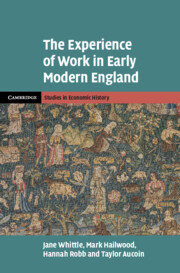Appendix A Relationship between Categories and Court Type

Notes: QS = quarter sessions; CC = church courts; CR = coroners’ reports.
Appendix A.1Long description
The table indicates labor tasks and their distribution across legal case types. The first column lists task categories, followed by tasks, percent of tasks from Q S, percent of tasks from C C, percent of tasks from C R, and top3 case types with percent of tasks in that category. The data is arranged below:
For Agriculture and land, the corresponding values are 2635, 36.8, 45.2, 18.0, and Tithe 30.4, Theft 23.9, Accidental death 18.0.
For Carework, the corresponding values are 564, 57.6, 39.7, 2.7, and Paternity 26.4, Testamentary 18.3, Miscellaneous 15.8.
For Commerce, the corresponding values are 2115, 74.2, 25.5, 0.3, and Theft 63.3, Tithe 7.0, Defamation 6.3.
For Crafts and construction, the corresponding values are 942, 49.5, 35.4, 15.2, and Theft 37.3, Accidental death 15.2, Defamation 12.7.
For Food processing, the corresponding values are 607, 75.3, 17.5, 7.2, and Theft 67.5, Accidental death 7.2, Defamation 5.6.
For Housework, the corresponding values are 748, 56.6, 25.5, 17.9, and Theft 41.3, Accidental death 17.9, Defamation 10.2.
For Management, the corresponding values are 645, 64.7, 34.7, 0.6, and Theft 45.6, Unclear 12.7, Miscellaneous 9.8.
For Transport, the corresponding values are 1237, 58.2, 21.3, 20.5, and Theft 39.9, Accidental death 20.5, Unclear 10.2.
For Other, the corresponding values are 157, 68.2, 22.9, 8.9, and Theft 30.9, Unclear 16.6, Witchcraft 14.6.
For Total, the corresponding values are 9650, 56.5, 32.2, 11.3, and Theft 40.5, Tithe 11.6, Accidental death 11.3.
